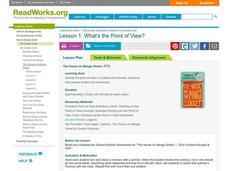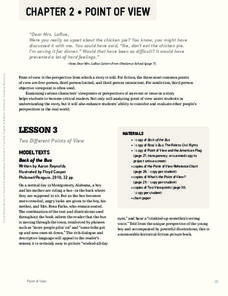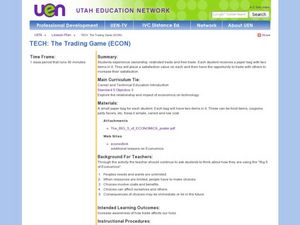Curated OER
Third-Person Limited, Omniscient or Objective Point of View?
Help your readers identify different points of view by studying key words the author uses to mold the story. There are four story excerpts provided here, and readers must identify the point of view, record the words that led them to that...
Curated OER
What's the Point of View?
Sixth graders explain what a point of view is. They list two different types of examples of third person point of view and identify the difference between a third person limited and third person omniscient . Additionally, they read a...
Curated OER
What's the Point of View?
What is the point of view? Sixth graders discuss third person limited and omniscient perspectives while reading several short stories. Then, complete a worksheet and share findings with peers.
Curated OER
Marking Time
Two narrative excerpts tell the same story from different points of view. In the first excerpt (first person), sequencing words and phrases are bolded and learners write down what the bold type does. The second excerpt is in third...
Curated OER
Third Person Limited and Omniscient Points of View
Students determine the point of view from each paragraph of the worksheet they are given. In this point of view worksheet, students read paragraphs in the third person either limited or omniscient.
Curated OER
Is There a Limit to Which Side You Can Take?
Calculus students find the limit of piecewise functions at a value. They find the limit of piecewise functions as x approaches a given value. They find the limit of linear, quadratic, exponential, and trigonometric piecewise functions.
Curated OER
Identifying Narrative Perspective 4
In this narrative perspective instructional activity, students identify the narrative perspective of paragraphs read including first, second, third person, and more. Students complete 9 problems.
Manchester College
What’s Your Point of View?
Work on deciphering the point of view of various pieces of literature. As readers review the concepts of first, second, and third person perspective, they apply what they know to different passages.
Curated OER
The Derivative as a Limit
Students investigate derivatives. In this calculus lesson, students investigate the derivative as a limit through the use of the TI-89.
Santa Ana Unified School District
The Power of Point of View
Sometimes a whole story can change based on the perspective of the person telling it. Practice identifying and analyzing point of view in various reading passages and writing assignments with a language arts packet, complete with Common...
Roald Dahl
Matilda - The Third Miracle
Magnus takes a visit to the classroom in the 20th chapter of Matilda. Or does he? After reading, learners interview the person in the hot seat to get a detailed account of what happened during this chapter. Then, they write individual...
Reed Novel Studies
Third Grade Angels: Novel Study
A million things to do, a ton of homework ... hyperbole sure does help get the point across! With the novel study for Jerry Spinelli's Third Grade Angels, scholars practice writing their own exaggerated sentences. Additionally, they...
Scholastic
Point of View
The point of view in a story can dramatically change the story itself. Focus on finding the points of view in various reading passages with a language arts packet, which includes fiction and nonfiction text.
Reed Novel Studies
Fourth Grade Rats: Novel Study
Things sure change in year's time. Suds, from Fourth Grade Rats, went from a third grade angel to a fourth grade rat! Although he is not necessarily happy with his new self, he worries he will lose his popularity. Learners complete...
Scholastic
A Tale to Tell!
A creative spin occurs when one pupil acts as author Ann M. Martin. Using a Q & A at the back of her book A Dog's Life, other classmates ask the "author" questions. They discuss the reasons why they know the book is from a...
Curated OER
Identify Narrative Perspective
In this narrative perspective worksheet, students read passages and determine point of view: first, second, third person objective/limited/omniscient.
Curated OER
Point of View Flash Cards
In this point of view flash cards worksheet, 8th graders create a set of flash cards for story writing perspective (first,n second, third person) with name and definition on one side and an example on the other.
Curated OER
Narrative Perspective
Students explore narration in writing by reading writing samples. In this narrative perspective lesson, students identify the differences between first, second, and third person perspectives. Students read writing examples and identify...
Curated OER
"The Tell-Tale Heart"- It's a Matter of Point of View
How does the point of view of Poe's protagonist in "The Tell-Tale Heart" contribute to the suspenseful tone? Help your middle schoolers identify the point of view in a literary work with this instructional activity, which goes on to...
Curated OER
Statements and Questions
Teach your class the differences between statements and questions with a simple activity. After reading four statements, third graders rewrite the sentences as questions. They do the opposite in the last section. A helpful activity for...
Curated OER
Shortened Words
Shorten names and words with different activities. Nicknames, acronyms, and shortened words (fridge instead of refrigerator, for example) are ways for third graders to build their vocabulary and differentiate between formal and informal...
Curated OER
TECH: The Trading Game
Property ownership, restricted trade, and free trade are the topics of this game. Kids play a trade game to better understand the interrelationship between technology, economics, and personal choices. Rules to the game and a series of...
Judicial Learning Center
Judicial Independence
Most people support the idea of an independent judiciary in theory until they hear about a court case that violates their principles. An informative resource explains why the concept is important. It also provides scholars of criminology...
Curated OER
Can You Make a Muscle?
Why are muscles important? Third graders study the different kinds and functions of muscles in the human body. After drawing arrows in an illustration to indicate where a muscle contraction would occur, they do their own experiment about...






















